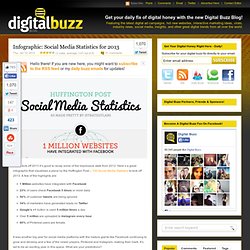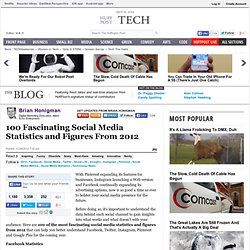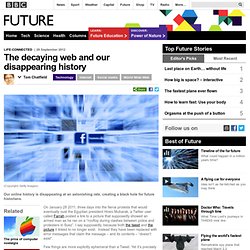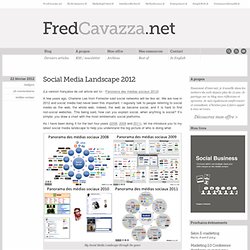

Digital Buzz » Infographic: Social Media Statistics for 2013. As we kick off 2013 it’s good to recap some of the impressive stats from 2012.

Here’s a great infographic that visualises a piece by the Huffington Post – 100 Social Media Statistics to kick off 2013. A few of the highlights are: 1 Million websites have integrated with Facebook 23% of users check Facebook 5 times or more daily56% of customer tweets are being ignored34% of marketers have generated leads on TwitterGoogle’s +1 button is used 5 million times a dayOver 5 million are uploaded to Instagram every hour80% of Pinterest users are female It was another big year for social media platforms with the mature giants like Facebook continuing to grow and develop and a few of the newer players, Pinterest and Instagram, making their mark.
It’s set to be an exciting year in this space. Thanks for the Infographic iStrategyLabs. Be Sociable, Share! Internet Slang words - Internet Dictionary - InternetSlang.com. Brian Honigman: 100 Fascinating Social Media Statistics and Figures From 2012. With Pinterest expanding its features for businesses, Instagram launching a Web version and Facebook continually expanding its advertising options, now is as good a time as ever to bolster your social media presence for the future.

Before doing so, it's important to understand the data behind each social channel to gain insights into what works and what doesn't with your audience. Here are 100 of the most fascinating social media statistics and figures from 2012 that can help you better understand Facebook, Twitter, Instagram, Pinterest and Google Plus for the coming year. Facebook Statistics 1. Barack Obama's victory Facebook post was the most liked photo on Facebook with over 4 million likes. Twitter Statistics 21. Instagram Statistics 41. Pinterest Statistics 61. 97 percent of the fans of Pinterest's Facebook page are women. Future - Technology - The decaying web and our disappearing history. Our online history is disappearing at an astonishing rate, creating a black hole for future historians.

On January 28 2011, three days into the fierce protests that would eventually oust the Egyptian president Hosni Mubarak, a Twitter user called Farrah posted a link to a picture that supposedly showed an armed man as he ran on a “rooftop during clashes between police and protesters in Suez”. I say supposedly, because both the tweet and the picture it linked to no longer exist. Instead they have been replaced with error messages that claim the message – and its contents – “doesn’t exist”. Few things are more explicitly ephemeral than a Tweet. Yet it’s precisely this kind of ephemeral communication – a comment, a status update, sharing or disseminating a piece of media – that lies at the heart of much of modern history as it unfolds.
Consider a study published this September by Hany SalahEldeen and Michael L Nelson, two computer scientists at Old Dominion University. Unravelling history. How to Cite Something You Found on a Website in APA Style. By Chelsea Lee Perhaps the most common question we get about APA Style is “How do I cite a website?”

Or “How do I cite something I found on a website?” First, to cite a website in general, but not a specific document on that website, see this FAQ. Once you’re at the level of citing a particular page or document, the key to writing the reference list entry is to determine what kind of content the page has. The Publication Manual reference examples in Chapter 7 are sorted by the type of content (e.g., journal article, e-book, newspaper story, blog post), not by the location of that content in a library or on the Internet. What seems to flummox our readers is what to do when the content doesn’t fall into an easily defined area. Content in that egg white area may seem confusing to cite, but the template for references from this area is actually very simple, with only four pieces (author, date, title, and source):
Social Media Landscape 2012. (La version française de cet article est ici : Panorama des médias sociaux 2012) A few years ago, Charlene Lee from Forrester said social networks will be like air.

We are now in 2012 and social media had never been this important. I regularly talk to people referring to social media as the web, the whole web. Indeed, the web as became social, and it is hard to find non-social websites. This being said, how can you explain social, when anything is social? As I have been doing it for the last four years (2008, 2009 and 2011), let me introduce you to my latest social media landscape to help you understand the big picture of who is doing what. Following a blurry 2010 in which I was unable to draw a consistent chart, the latest version was divided into seven major use and a central position for Facebook and Google.
A very dense ecosystem As for the usages, I have spread the various services over families: